Kohl (cosmetics)
Kohl (Arabic: كُحْل kuḥl) is an ancient eye cosmetic, traditionally made by grinding stibnite (Sb2S3) for similar purposes to charcoal used in mascara. It is widely used in the Middle East, the Mediterranean, South Asia, and the Horn of Africa as eyeliner to contour and/or darken the eyelids and as mascara for the eyelashes. It is worn mostly by women, but also by some men and children.
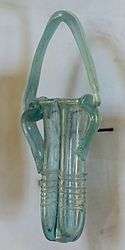
Kohl has also been used in India as a cosmetic for a long time. In addition, mothers would apply kohl to their infants' eyes soon after birth. Some did this to "strengthen the child's eyes", and others believed it could prevent the child from being cursed by the evil eye.[1]
Name
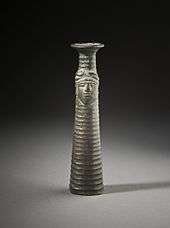
The Arabic name كحل kuḥl and the Biblical Hebrew כחל kaḥal [2] (cf. modern Hebrew כחול "blue") are cognates, from a Semitic root k-ḥ-l. Transliteration variants of Arabic dialectal pronunciation include kohl or kuhl.
The English word alcohol is a loan of the Arabic word (via Middle Latin and French; originally in the sense "powder of antimony", the modern meaning is from the 18th century).
The Persian word for kohl is سرمه sormeh, from Turkish sürme "drawing along", which has led to Bengali and Urdu surma ( সুর্মা, سرمہ) as well as Russian сурьма. In some South Asian languages, the term kājal or kajol is used. This last term may originally have a Dravidian root.[3]
In Hausa, it is also known as tozali and kwalli.[4]
The Greek and Latin terms for antimony, stibium, στίβι, στίμμι, were borrowed from the Egyptian name sdm.
Middle East and North Africa
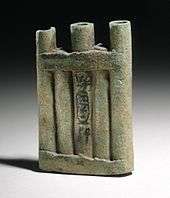
Kohl has been worn traditionally since the Protodynastic Period of Egypt (ca. 3100 BCE) by Egyptian queens and noble women, who used stibnite (the sulfide of antimony rather than of lead). The cosmetic palettes used for its preparation assumed a prominent role in the late Predynastic Egyptian culture.
Kohl was originally used as protection against eye ailments. There was also a belief that darkening around the eyes would protect one from the harsh rays of the sun.
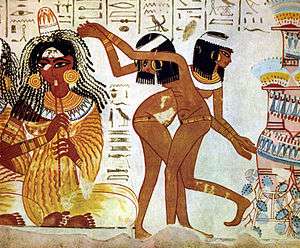
Galena eye paint (later termed Kohl in Arabic from the Akkadian word for the cosmetic) was widely applied in Ancient Egypt. Upper eyelids were painted black and lower ones were colored green, as depicted in ancient texts that describe the use of both black galena and green malachite. Ancient graves from the pre-historic Tasian culture point to the early application of galena in Egypt, a custom stretching from as old as the Badarian period through to Greco-Roman era. Although found locally, both black galena and green malachite were also imported from nearby regions in Western Asia, Coptos and the Land of Punt.[5]
The 18th Dynasty Ancient Egyptian Queen Hatshepsut would also grind charred frankincense into kohl eyeliner. This is the first recorded use of the resin.[6] The frankincense itself had originally been obtained during an expedition to the ancient Land of Punt in this New Kingdom dynasty (c. 1500 BC).[7] Cosmetic ingredients such as cinnamon bark and other spice components – used for fragrances – alongside copper kohl sticks were exported from Tamraparni (ancient Sri Lanka) towns Pomparippu and Kadiramalai-Kandarodai to ancient Egypt.[8][9][10][11]
Additionally, the pioneering Muslim scholar Ibn Abi Shayba described in a legal compilation how to apply kohl to the eye, as narrated by earlier authorities.[12]
Berber and Semitic women in North Africa and the Middle East, respectively, also apply kohl to their faces. A vertical line is drawn from the bottom lip to the chin and along the bridge of the nose. Originally the line from the bottom lip to the chin shows whether a woman is married or not. This form of using Kohl on the face originates from the Arabian Peninsula, and was introduced in the 7th century in North-Africa.[13]
Eye paint was worn in ancient Israel as well; one of Job's daughters had the name Keren-Happuch ("horn ofeye paint") (Job42:14). Among the Israelites, the eye paint was frequently associated with women of ill repute of evil intent : "When Jehu came to Jezreel, , Jezebel heard of it ; she painted her eyes with kohl ("wattāśem bappûk"), and adorned her head, and looked out of the window" (2 Kings 9:30). For Jeremiah, Jerusalem can be personnified as a prostitute: "And you, O desolate one, what do you mean that you dress in crimson, that you deck yourself with ornaments of gold, that you enlarge your eyes with kohl ("tiqrĕ'ĭ bappûk") ?" (Jer. 4:30). Similarly, Ezekiel portrays unfaithful Jersualem as the prostitute Oholobah: "They even sent for men to come from far away, to whom a messenger was sent, and they came. For them you bathed yourself, painted ("kaḥal") your eyes, and decked yourself with ornaments" (ezek. 23:40).[14]
Horn of Africa

Usage of kohl eye paint in the Horn of Africa dates to the ancient Kingdom of Punt.[5] Somali, Djiboutian, Ethiopian and Eritrean women have long applied kohl (kuul) for cosmetic purposes, as well as to cleanse the eyes, lengthen eyelashes, and to protect the eyes from the sun's rays.[15][16]
West Africa
Kohl is also applied in parts of West Africa by the Fulani, the Hausa people and the Tuareg.[17] In addition, it is used by the Wolof, Mandinka, Soninke, Dagomba, Kanuri, and other predominantly Muslim inhabitants of the Sahel and Sahara regions. Kohl is used by both sexes, and by people of all ages, mainly during weddings, Islamic festivals (such as Eid ul Fitr and Eid ul Adha), and trips to the mosque for the weekly Jumuah congregational prayer.
For women, kohl or black-henna is applied to the face as well in a similar manner as that practiced by communities in North Africa.
South Asia

Kohl is known by various names in South Asian languages, like surma in Punjabi, Sylheti and Urdu, kajal in Hindi and Gujarati, kajol in Bengali, kajalh in Marathi, kanmashi in Malayalam, kaadige in Kannada, kaatuka in Telugu and kan mai in Tamil. In India, it is used by women as a type of eyeliner that is put around the edge of the eyes. In many parts of India, especially in Southern India, Karnataka in particular, women of the household prepare the kajal. This homemade kajal is used even for infants. Local tradition considers it to be a very good coolant for the eyes and believes that it protects the eyesight and vision from the sun.
Some Indian Ayurvedic or Ancient Indian Herbal medicines manufacturing companies add camphor and other medicinal herbs that are beneficial for eyes in their kajal. It can serve not only as a cosmetic but also as medicine for the eyes.
In Punjabi culture, surma is a traditional ceremonial dye, which predominantly men of the Punjab wear around their eyes on special social or religious occasions. It is usually applied by the wife or the mother of the person.
Some women also add a dot of kajal on the left side of the foreheads or on the waterline of the eye of women and children to ward off buri nazar, also known as buri nozor. Buri nazar literally means 'bad glance' and is comparable to the 'evil eye', although it can be interpreted as ill-wishes of people or even lustful eyes, in the sense of men ogling women. It signifies that the person is not perfect, with them having 'black mark', and hence, people wouldn't be jealous of their beauty. In the centuries-old Indian Bharatnatayam dances, the dancers apply heavy kohl to their eyes so as to draw attention to their eye gestures and movement. The kohl is then applied to eyebrows and eyelids to add further enhancement to the dancers.
Kohl and Islam
In Islam, Muhammad used kohl and recommended others to use it because he believed that it was beneficial for the eyes[18] based on the following saying by him: "One of the best kinds of kohl that you use is Ithmid (antimony); it brightens the vision and makes the hair (eye-lashes) grow"[19] and he "used to apply kohl to his right eye three times, and to his left eye twice."[18] It is used by many Muslim men today during Ramadan as a sign of devotion[20][21][22] although the practice is not universally agreed upon as being based on authentic sources.[23]
Preparation
Preparation of homemade kajal begins with dipping a clean, white, thin muslin cloth, about four by four inches square, in sandalwood paste or the juice of Alstonia scholaris (Manjal karisilanganni), which is then dried in the shade. This dip and dry process is done all day long. After sunset, a wick is made out of the cloth, which is then used to light a mud lamp filled with castor oil. A brass vessel is kept over the lamp, leaving a little gap, just enough for the oxygen to aid the burning of the lamp. This is left burning overnight. In the morning, one or two drops of pure ghee (clarified cow's butter) or castor oil are added to the soot which now lines the brass vessel. It is then stored in a clean dry box.
All the ingredients used in this preparation (sandalwood/Manjal karsilanganni, castor oil, ghee) are believed to have medicinal properties. They are still used in Indian therapies like ayurveda and Siddha medicines.
In rural Bengal, kajol or surma is made from the "Monosha" plant, a type of succulent spurge (Euphorbia neriifolia). The leaf of Monosha is covered with oil and is kept above a burning diya (mud lamp). Within minutes the leaf is covered with creamy soft black soot which is so safe and sterile that it is even applied to infants.
Health concerns
The content of kohl and the recipes to prepare it vary greatly. In North Africa and Middle East, homemade kohl is often made by grinding galena (lead sulfide). Western manufacturers use amorphous carbon or organic charcoal instead of lead. Plant oils and the soot from various nuts, seeds, and gum resins are often added to the carbon powder. The non-lead products are considered to be of inferior quality to the older, traditional varieties and therefore there has been an increase in the use of handmade, lead-based kohl.
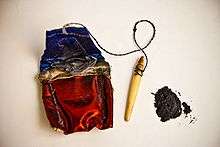
For decades various conflicting reports in the literature have been published relating to kohl application to eyes being responsible for causing higher blood lead concentration, which may cause lead poisoning. While at the same time, a number of research studies and reports have also been published refuting any such links with increased blood lead level upon kohl (surma) application.[24]
A group of researchers in China tried to find some scientific basis of this claimed property of lead sulphide (galena) relating to absorption of sun rays when applied into the eyes in the form of kohl.[25] The authors reported the ultraviolet (UV) absorption spectra of a thin film of lead sulphide prepared on "Indium Tin Oxide" (ITO) substrate. The spectra showed that lead sulphide thin films had higher absorption and lower transmittance in UV light band which further increases with the increased deposition voltage.
The drive to eliminate lead from kohl was sparked by studies in the early 1990s of preparations of kohl that found high levels of contaminants, including lead.[26][27][28] Lead levels in commercial kohl preparations were as high as 84%. Kohl samples from Oman and Cairo, analyzed using X-ray powder diffraction and scanning electron microscopy, found galena.[1][26] One decade later, a study of kohl manufactured in Egypt and India found that a third of the samples studied contained lead, while the remaining two-thirds contained amorphous carbon,[1] zincite,[1][26] cuprite,[1] goethite,[1] elemental silicon[1] or talc,[1] hematite, minium,[26] and organic compounds.[1]
Lead-contaminated kohl use has been linked to increased levels of lead in the bloodstream,[29][30][31][32] putting its users at risk of lead poisoning and lead intoxication. Complications of lead poisoning include anemia, growth retardation, low IQ, convulsions, and in severe cases, death. Anemia from lead poisoning is of special concern in Middle Eastern and South Asian countries where other forms of anemia are prevalent, including iron deficiency anemia (from malnutrition) and hemoglobinopathy (sickle cell anemia, thalassemia).
These banned products are different from lead-free cosmetics that use the term "kohl" only to describe its shade/color, rather than its actual ingredients. Some modern eye cosmetics are marketed as "kohl", but are prepared differently and in accordance with relevant health standards.
Eye cosmetics such as surma are recognized as one of the important sources of lead exposure in Pakistan. As adverse health effects of heavy metals are a public health concern, where especially lead may cause negative health impacts to human fetal and infantile development, a study in Pakistan of pregnant women' nails in 2016, showed thirteen nail samples out of 84 nails analyzed, contained lead higher than the concentration (13.6 μg/g) of the fatal lead poisoning case, with the possibility of an external contamination. The observations showed that lead-containing surma consists of fine particle of galena (ore of lead sulfide) in respirable dust range (less than 10 μm) and relative in vitro bioavailability of lead in the surma was determined as 5.2%. Thus, lead-containing surma consists of inhalable and bioavailable particles, and it contributes an increased risk of lead exposure.[33]
"Blue" Kohl is a dark-bluish black pigment composed of both lead-based compounds as well as a compound of antimony. The lead-based compounds in kohl are galena (PbS) – dark grey and gloss laurionite ( PbCl(OH)) – white phosgenite ((PbCl)2CO3); cerussite (PbCO3) – blue. The antimony-based compound in kohl is stibnite (Sb2S3) – blue.
In January 2010, French researchers reported that the particular heavy eye makeup that ancient Egyptians wore may have had medical benefits. At submicromolar concentrations, the specially made lead compounds can elicit overproduction of nitrous oxide (N2O), which in turn can trigger an enhancement of the immune response.[34][35]
The ancient Egyptians, documented in the Ebers Papyrus (c. 1550 BCE), discuss these compounds within kohl as protective for the eyes. Indeed, kohl was used an eyeliner and cosmetic. There are a number of endemic ocular diseases in the Nile region including trachoma, a chlamydial organism which can cause corneal scarring and conjunctival cicatricial disease, with visual loss. Kohl was used not only as a cosmetic but also as a medicinal collyrium (from Gr. kollurion). Two of kohl's lead compounds — the lead chlorides laurionite and phosgenite — were not natural to the Nile valley. It is believed they were intentionally synthesized by the ancient Egyptians for this purpose. The widespread use of kohl across the Mediterranean and the Mid-east attests to its ability to protect the eye from infectious disease and be used as a cosmetic.[36]
Legal status
Kohl is not on the list of color additives approved by the Food and Drug Administration, which considers kohl unsafe for use due to its potential lead content. It is thus illegal to import into, or sell in, the United States.[37]
In popular culture
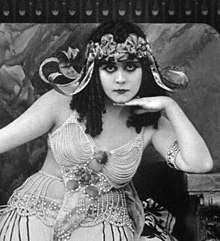
- At the beginning of the 1999 British film East is East, the character George Khan played by Om Puri applies kohl to his son's eyes before his wedding.
- The film actress Theda Bara used kohl to rim her eyes throughout her career.
- In the BBC Four program Lost Weekend which he curated, Rolling Stones guitarist Keith Richards attributes his use of kohl to the Semi-nomadic tribes of North Africa, where he vacationed frequently in the late 1960s.
- Marc Antony in the HBO series Rome is seen wearing Kohl along with many of the Egyptian characters.
- Jack Sparrow, a character in the Pirates of the Caribbean films, wears kohl around his eyes.
- Prince wore kohl around his eyes throughout his career.
- Edward Gorey wrote: "The Wanton, though she knows its dangers / must needs smear Kohl about her eyes / and wake the interest of strangers / with long-drawn, hoarse, erotic sighs."
- In the song "Miss Sarajevo" by Passengers (a collaboration between U2 and Brian Eno), a line asks "Is there a time for kohl and lipstick? / a time for curling hair / is there a time for High Street shopping? / to find the right dress to wear".
- Mariska Veres, lead singer for the Dutch rock group Shocking Blue, wore kohl around her eyes.
- In the webcomic Gunnerkrigg Court, kohl is referenced by the name surma, which is the protagonist's mother's name, and the protagonist's name is antimony, an ingredient of kohl.
- Charley, a character in the 2009 film A Single Man, used kohl to prepare herself for a dinner date.
- Rabia, a character in the 2010 Pakistani drama Dastaan, used kohl to line Bano's eyes to enhance her beauty.
- Raees (played by Shah Rukh Khan) a character in the 2017 Indian crime-action film Raees, wears kohl in the whole film as a part of his character.
See also
References
Notes
- Hardy A, Walton R, Vaishnav R., Int J Environ Health Res. 2004 Feb;14(1):83–91. Composition of eye cosmetics (kohls) used in Cairo.
- Strong's Concordance H3583
- McGregor, R.S. (1993). The Oxford Hindi-English Dictionary. Oxford: Oxford University Press. ISBN 978-0195638462.
- Kay Lazar Folk remedy linked to baby’s high lead levels, Boston Globe, 2 August 2012.
- Studies in Ancient Technology, Volume III, (Brill Archive), p.18.
- Isaac, Michael (2004). A Historical Atlas of Oman. The Rosen Publishing Group. p. 14. ISBN 978-0823945009. Retrieved 5 September 2014.
- Martin Watt, Wanda Sellar (2012). Frankincense & Myrrh: Through the Ages, and a complete guide to their use in herbalism and aromatherapy today. Random House. p. 24. ISBN 978-1446490778. Retrieved 11 November 2016.
- Uragoda, C. G. (1987). A history of medicine in Sri Lanka from the earliest times to 1948. Sri Lanka Medical Association. p. 8. Retrieved 22 June 2019.
- Intirapālā, Kārttikēcu (2005). The evolution of an ethnic identity: the Tamils in Sri Lanka c. 300 BCE to c. 1200 CE. M.V. Publications for the South Asian Studies Centre, Sydney. p. 63. ISBN 9780646425467.
- International Journal of Dravidian Linguistics. Department of Linguistics, University of Kerala. 2009. p. 62.
- Brand, Chad; Mitchell, Eric; Staff, Holman Reference Editorial (2015). Holman Illustrated Bible Dictionary. B&H Publishing Group. p. 351. ISBN 9780805499353. Retrieved 22 June 2019.
- Simon Swain, George Boys-Stones (2007). Seeing the Face, Seeing the Soul: Polemon's Physiognomy from Classical Antiquity to Medieval Islam. Oxford University Press. p. 277. ISBN 978-0199291533.
- Many Mirrors: Body Image and Social Relations. Nicole Landry Sault.
- King, P. J., & Stager, L. E. (2001). Life in biblical Israel. Westminster John Knox Press. url=https://books.google.fr/books?id=OtOhypZz_pEC&pg=PA281&lpg=PA281&dq=kohl+hebrew+puk&source=bl&ots=k2Tpxo5uns&sig=ACfU3U1HFG4vJ6x0Jh1uNnqbO4GhLe40pA&hl=fr&sa=X&ved=2ahUKEwiCuueJ4sroAhVF1xoKHSdsDHEQ6AEwAHoECAoQLw#v=onepage&q&f=false
- Katheryne S. Loughran, Somalia in word and image, (Foundation for Cross Cultural Understanding: 1986), p.166.
- Sergew Hable Selassie, Ancient and medieval Ethiopian history to 1270, (Printed by United Printers: 1972), p.26.
- Alan Donovan, My journey through African Heritage, (Kenway Publications: 2004), p.62.
- IslamQA fatwa 44696: "Pure kohl is beneficial to the eyes and is not harmful" retrieved September 18, 2015
- “Sunan an-Nasa'i 5113: Vol. 6, Book 48, Hadith 5116”
- Merdeka: "Tradisi unik muslim Yaman rias mata dengan kohl saat Ramadan"
- "Proverb of the day: Instead of applying kohl to her eyes, he blinded her" Ahram Online. Friday 3 July 2015
- Wall Street Journal: "KOHL IN HIS EYE: A man winced as kohl was applied to his eyelids at the Grand Mosque during the Muslim holy fasting month of Ramadan in San'a, Yemen July 27, 2013
- “Bulugh al-Maram The Book on Fasting: Book 5, Hadith 689”
- Mahmood ZA, Zoha SM, Usmanghani K, Hasan MM, Ali O, Jahan S, Saeed A, Zaihd R, Zubair M., Pak. J. Pharm. Sci., Vol.22, No.1, January 2009, pp. 107–122. "KOHL (SURMA): RETROSPECT AND PROSPECT"
- Li-Yun C, Wen H, Jian-Feng H and Jian-Peng W (2008). "Influence of deposition voltage on properties of lead sulfide thin film." American Ceramic Society Bulletin, 87(6): 9101–9104
- Hardy AD, Vaishnav R, Al-Kharusi SS, Sutherland HH, Worthing MA., J Ethnopharmacol. 1998 Apr;60(3):223–34. "Composition of eye cosmetics (kohls) used in Oman."
- al-Hazzaa SA, Krahn PM., Int Ophthalmol. 1995;19(2):83–8. "Kohl: a hazardous eyeliner."
- Parry C, Eaton J., Environ Health Perspect. 1991 Aug;94:121–3. "Kohl: a lead-hazardous eye makeup from the Third World to the First World."
- Alkhawajah AM. "Alkohl use in Saudi Arabia: Extent of use and possible lead toxicity." Tropical Geographical Medicine, 1992 Oct; 44(4):373–7.
- Al-Saleh I, Nester M. DeVol E, Shinwari N, Al-Shahria S. "Determinants of blood lead levels in Saudi Arabian schoolgirls." International Journal of Environmental Health, 1999 Apr–Jun; 5(2):107–14.
- Nir A, Tamir A, Nelnik N, Iancu TC. "Is eye cosmetic a source of lead poisoning?" Israel Journal of Medical Science, 1992 Jul; 28(7):417–21.
-
- Rahbar MH, White F, Agboatwalla M, Hozhbari S, and Luby S. "Factors associated with elevated blood lead concentrations in children in Karachi, Pakistan." Bulletin of the World Health Organization. 2002, 80(10):769–775.
- Ikegami, Akihiko; Takagi, Mai; Fatmi, Zafar; Kobayashi, Yayoi; Ohtsu, Mayumi; Cui, Xiaoyi; Mise, Nathan; Mizuno, Atsuko; Sahito, Ambreen (2016-11-01). "External lead contamination of women's nails by surma in Pakistan: Is the biomarker reliable?". Environmental Pollution. 218 (Supplement C): 723–727. doi:10.1016/j.envpol.2016.07.068. PMID 27554978.
- Tapsoba, et al. Journal of Analytic Chemistry 2010 http://pubs.acs.org/doi/pdf/10.1021/ac902348g
- National Geographic "Cleopatra's eye makeup"
- i, Tapsoba; s, Arbault; p, Walter; c, Amatore (2010). "Finding out egyptian gods' secret using analytical chemistry: Biomedical properties of egyptian black makeup revealed by amperometry at single cells". Analytical Chemistry. 82 (2): 457–60. doi:10.1021/ac902348g. PMID 20030333.
- "Kohl, Kajal, Al-Kahal, Surma, Tiro, Tozali, or Kwalli: By Any Name, Beware of Lead Poisoning". Food and Drug Administration. Retrieved 2017-10-26.
Bibliography
- Al-Ashban RM, Aslam M, Shah AH., Public Health. 2004 Jun;118(4):292–8. "Kohl (surma): a toxic traditional eye cosmetic study in Saudi Arabia."
- Abdullah MA., J Trop Med Hyg. 1984 Apr;87(2):67–70. "Lead poisoning among children in Saudi Arabia."
- Hardy AD, Walton RI, Myers KA, Vaishnav R., J Cosmet Sci. 2006 Mar–Apr;57(2):107–25. "Availability and chemical composition of traditional eye cosmetics ('kohls') used in the United Arab Emirates of Dubai, Sharjah, Ajman, Umm Al-Quwain, Ras Al-Khaimah, and Fujairah."
- Shaltout A, Yaish SA, Fernando N., Ann Trop Paediatr. 1981 Dec;1(4):209–15. "Lead encephalopathy in infants in Kuwait. A study of 20 infants with particular reference to clinical presentation and source of lead poisoning."
External links
| Wikimedia Commons has media related to kohl. |
| Look up kohl in Wiktionary, the free dictionary. |
- Kohl – The Dark World,
- Egyptian: Kohl pot, Black steatite, click on picture.
- Egyptian: Bone kohl pot. Figurine design, click on picture.
- Kohl (CopperWiki)

.jpg)